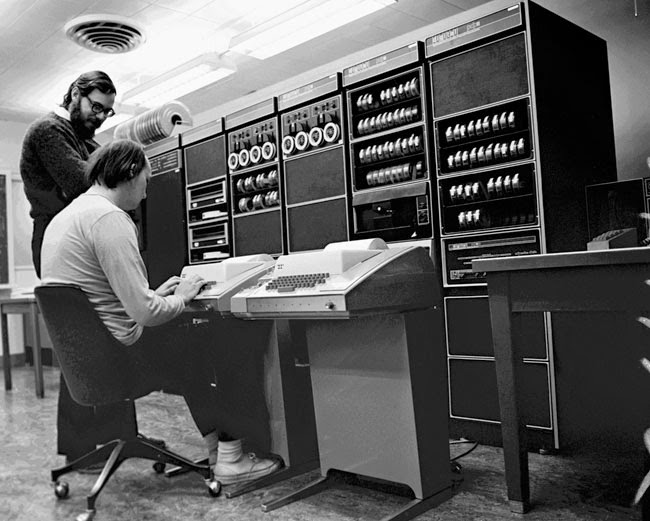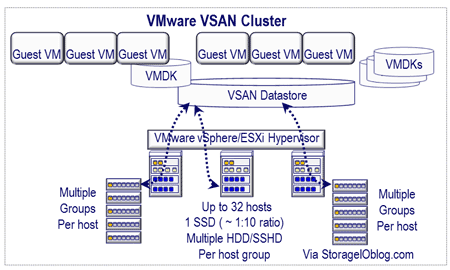Only a few quick updates today, mostly around hyper-converged infrastructures and Software-defined datacenter. Two trends that obviously go hand in hand. Plus some hot Flash-memory news at the end.
That very topic is discussed in this great overview by George Crump of Storage Switzerland: "A core component of a HCA is SDS. Most HCA solutions are scale-out SDS solutions that run on each node in a hypervisor cluster. They then aggregate the storage in each node to create a shared storage pool accessible by all the virtual machines in the cluster. The value of HCA is that it eliminates a specialized storage network and significantly reduces the cost of storage, since a dedicated shared storage system is not needed. Like any other SDS solution, these HCA solutions then provide most of the necessary storage services like snapshots and cloning but many are missing key services like data protection and replication. For small organizations, a HCA may be all the business needs."
Read the details here!
And for short video to put things into perspective and make sure hype does not go thru the roof, watch this Toigo-clip here!
SDDC also was one of the major topics during the recent VMworld conference which took place in San Francisco: actually VMware renamed their previously discussed EVO:Rack product into EVO SDDC - to my knowledge the first real product being released under that name.
The related marketing lingo sounds as follows: "With our vision for SDDC, VMware has led the way to the next-generation data center architecture. We believe the SDDC is the best architecture for the cloud. By adopting a software-driven, automated approach to data center design and management, organizations gain the IT efficiency, agility and control they need to compete and innovate while achieving tremendous savings — IT organizations can slash CAPEX by as much as 49 percent. (1)
The value of an SDDC-based private cloud has been well recognized by our customers who are asking us for way to accelerate their journey. With EVO SDDC, we are taking a major step forward in providing a turnkey solution that will help our customers to stand up a complete SDDC in a matter of hours and more efficiently manage it at data center scale."
Lastly: the race and journey to "storage after spinning rust" is in full swing. The Flash Memory Summit -which takes place in August- currently is the storage event to be and got a lot of attention from the industry and customers.
As you can read in this press release from HGST, much of the R&D investments go into research focusing on non-volatile memory ""post NAND-flash: "In-memory computing is one of today's hottest data center trends. Gartner Group projects that software revenue alone for this market will exceed US $9B by the end of 20183. In-memory computing enables organizations to gain business value from real-time insights by offering faster performance and greater scalability than legacy architectures."
And to conclude today's news on a local note: IBM Zurich Research made an important step to eliminate "drift" in PCM (phase change memory) devices: "Phase change memory (PCM) devices have been investigated since the early 1970s and in the past 12 months IBM scientists have made tremendous progress with this technology publishing a number of milestone papers which demonstrate multiple bits per cell, making the technology extremely competitive with Flash.
But PCM doesn’t come without some drawbacks — a primary culprit being resistance drift. Drift is the change in resistance of the stored levels over time. Essentially the data moves causing your text document or your photo to eventually become corrupted and unusable — a very bad characteristic for a storage technology."
VMware
EVO SDDC (previously code named VMware EVO: RACK™), will be a fully
automated software suite for delivering the software-defined data center
as an integrated system. Enterprises and service providers will be able
to use VMware EVO SDDC to deploy a software-defined data center at
scale. With VMware EVO SDDC, IT organizations can meet key data center
scale initiatives, ranging from application and infrastructure delivery
automation to business mobility to high availability and resilient
infrastructure, without compromising security, control or choice. - See
more at:
http://www.vmware.com/company/news/releases/vmw-newsfeed/VMware-Unveils-the-Easiest-Way-to-Deploy-and-Operate-the-Software-Defined-Data-Center-at-Scale/1984725#sf40638508
VMware
EVO SDDC (previously code named VMware EVO: RACK™), will be a fully
automated software suite for delivering the software-defined data center
as an integrated system. Enterprises and service providers will be able
to use VMware EVO SDDC to deploy a software-defined data center at
scale. With VMware EVO SDDC, IT organizations can meet key data center
scale initiatives, ranging from application and infrastructure delivery
automation to business mobility to high availability and resilient
infrastructure, without compromising security, control or choice. - See
more at:
http://www.vmware.com/company/news/releases/vmw-newsfeed/VMware-Unveils-the-Easiest-Way-to-Deploy-and-Operate-the-Software-Defined-Data-Center-at-Scale/1984725#sf40638508
VMware
EVO SDDC (previously code named VMware EVO: RACK™), will be a fully
automated software suite for delivering the software-defined data center
as an integrated system. Enterprises and service providers will be able
to use VMware EVO SDDC to deploy a software-defined data center at
scale. With VMware EVO SDDC, IT organizations can meet key data center
scale initiatives, ranging from application and infrastructure delivery
automation to business mobility to high availability and resilient
infrastructure, without compromising security, control or choice. - See
more at:
http://www.vmware.com/company/news/releases/vmw-newsfeed/VMware-Unveils-the-Easiest-Way-to-Deploy-and-Operate-the-Software-Defined-Data-Center-at-Scale/1984725#sf40638508
VMware
EVO SDDC (previously code named VMware EVO: RACK™), will be a fully
automated software suite for delivering the software-defined data center
as an integrated system. Enterprises and service providers will be able
to use VMware EVO SDDC to deploy a software-defined data center at
scale. With VMware EVO SDDC, IT organizations can meet key data center
scale initiatives, ranging from application and infrastructure delivery
automation to business mobility to high availability and resilient
infrastructure, without compromising security, control or choice. - See
more at:
http://www.vmware.com/company/news/releases/vmw-newsfeed/VMware-Unveils-the-Easiest-Way-to-Deploy-and-Operate-the-Software-Defined-Data-Center-at-Scale/1984725#sf40638508
VMware
EVO SDDC (previously code named VMware EVO: RACK™), will be a fully
automated software suite for delivering the software-defined data center
as an integrated system. Enterprises and service providers will be able
to use VMware EVO SDDC to deploy a software-defined data center at
scale. With VMware EVO SDDC, IT organizations can meet key data center
scale initiatives, ranging from application and infrastructure delivery
automation to business mobility to high availability and resilient
infrastructure, without compromising security, control or choice. - See
more at:
http://www.vmware.com/company/news/releases/vmw-newsfeed/VMware-Unveils-the-Easiest-Way-to-Deploy-and-Operate-the-Software-Defined-Data-Center-at-Scale/1984725#sf40638508


















